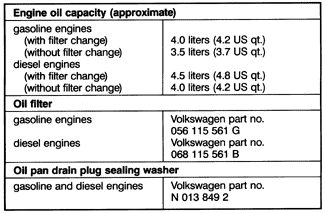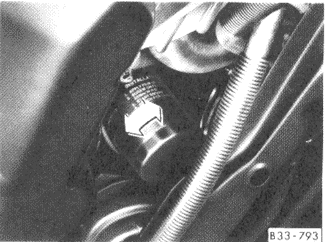4.1 Changing Engine Oil and Filter
The 7,500-mile or 6 month oil change interval specified in the maintenance schedule should be the basic guide to scheduling oil changes. Do not rely on the color of the oil on the dipstick to indicate when a change is needed. Because of the detergent additives in the oil, fresh oil will look dark after only a few hundred miles.
If the car is used primarily for short trips, or routinely operated in dusty conditions or slow-moving traffic, the oil should be changed more frequently. In general, changing the oil at more frequent intervals will help better protect the engine, and promote longer engine life. For diesel engines using SAE 10W-40 oil in winter, the oil should be changed every 3,000 miles (4800 km).
Although it is an acceptable practice to change the oil filter at every other oil change, reusing the old filter leaves about 1/2 quart of old oil in the lubrication system. The publisher recommends also changing the oil filter with every oil change, no matter what the interval.
A complete oil change requires approximately 5 US qt. of new oil (see 3. Fluid and Lubricant Specifications), a new oil filter, and a new drain plug sealing washer. Part numbers and oil capacities are given in Table g. The equipment needed, a drain plug socket or box wrench (19 mm), a drain pan of at least 6 US qt. (5.6 l) capacity, and an oil filter wrench, is described in FUNDAMENTALS.
Table g. Engine Oil Change Specifications

To change oil and filter:
| 1. | Run the car for a few minutes to slightly warm the engine and the oil, then shut the engine off. |
| 2. | With the car on level ground, place a drain pan under the oil drain plug shown in Fig. 4-3. |
| Fig. 4-3. | Engine oil drain plug (arrow) in oil pan underneath engine (shown from rear). |

|


